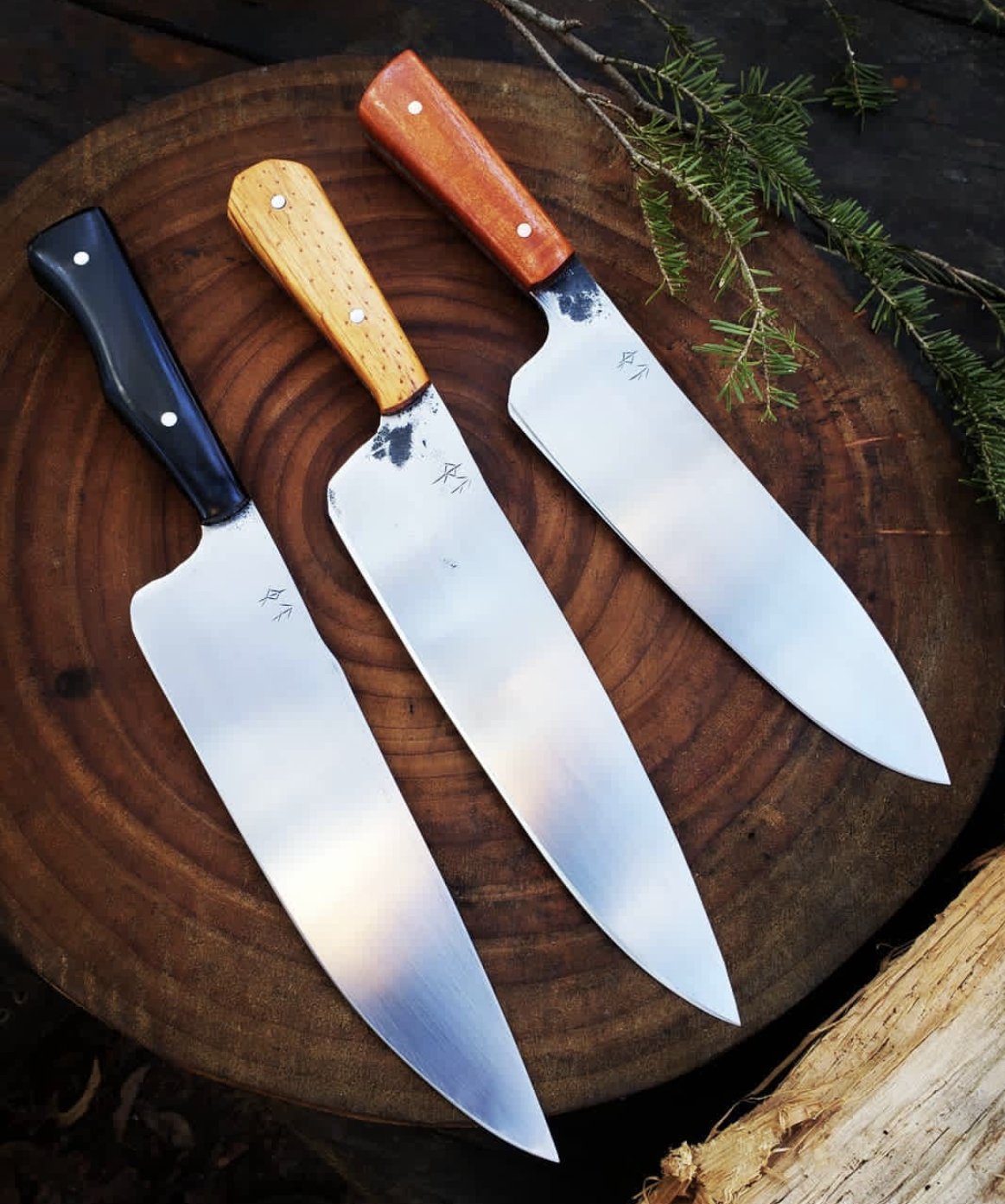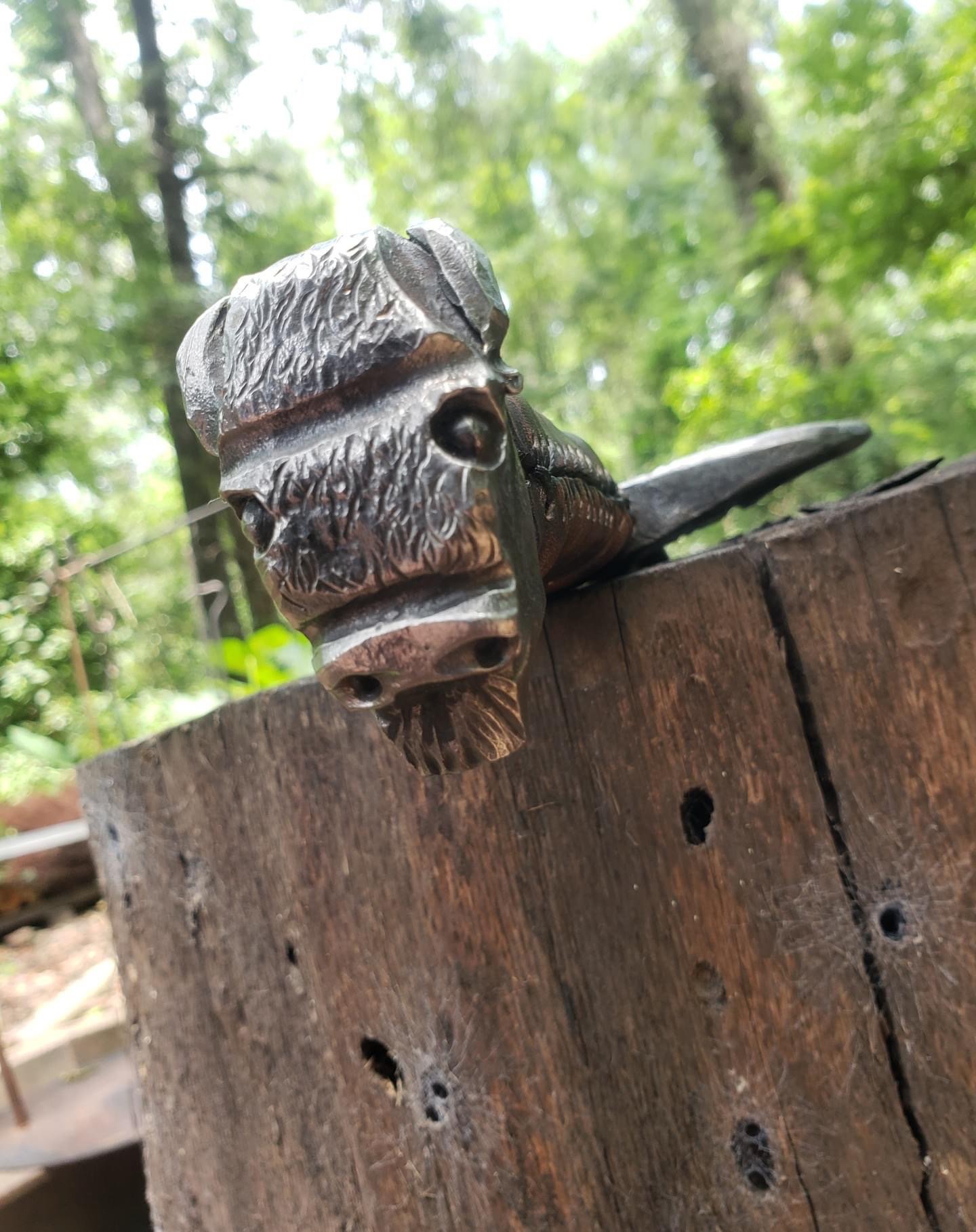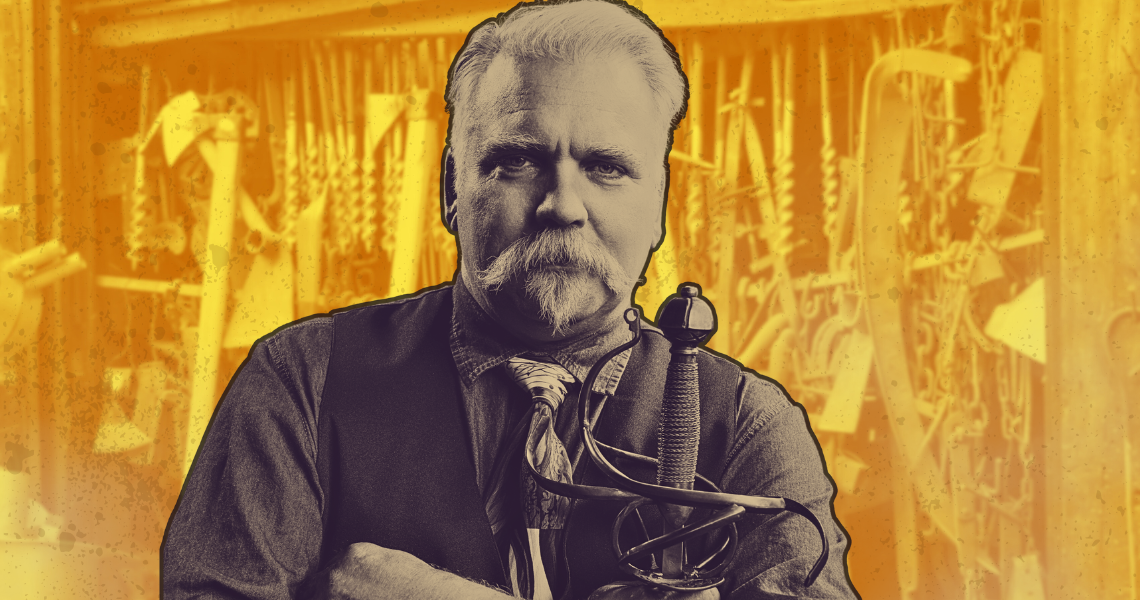Honoring the Ancient Traditions: Interview with Jordan Borstelmann of Crooked Path Forge
(Image credit: Jordan Borstelmann)
Today’s bladesmith interview is presented by our partners at Brownells. For over 80 years, Brownells has been providing quality gunsmithing tools, gun parts and service to the firearms industry. With a selection of over 90,000 gun parts, tools, and supplies, they have everything you need all in one place. Follow this link and use code AUG20 to save $20 on any order over $200!
Jordan Borstelmann is the owner of Crooked Path Forge in Gainesville, Florida. He is a full-time bladesmith, blacksmith, teacher, and mentor. He talked with us about how his journey to becoming a smith inspired the name of his forge, what he’s been up to lately, his appearance in season three of Last Blade Standing, and what he hopes to see in season four.
RELATED: EXCLUSIVE LBS SEASON 4 PREVIEW COMING AUGUST 19
BRUTE de FORGE: Hi Jordan! How's Florida today?
Jordan Borstelmann: Good! It's a little warm today. I just got back from Minnesota. I taught a class there last week, and we were right on Lake Superior. The highs were in the 60s there, so it was tough coming back to this heat.
BDF: How was your experience there?
JB: It was good! I taught at a craft school there and had a really good time. It's a nice place.
BDF: Do you do a lot of teaching like that, where you travel to different places?
JB: So, this is my first year traveling like this. Most of my career has been and is teaching. I hold classes and teach lessons, but last year, I decided to see if I could travel around and do it. I put out a bunch of resumes, class proposals, and all that. Hopefully, it keeps happening. I’m enjoying it.
Jordan’s entrance into blacksmithing
BDF: How did you get into forging?
JB: What made me want to try it in the first place was reading too many Conan the Barbarian books as a kid and playing lots and lots of Dungeons and Dragons! I was also fascinated with reading about medieval history.
RELATED: FIVE OF THE MOST DANGEROUS SWORDS IN DUNGEONS AND DRAGONS
However, the first time I ever did any blacksmithing was when I went to a craft school in North Carolina called the Penland School of Crafts. I did a beginning blacksmithing course there that was two weeks long, and it was super intense. I had never swung a hammer before that; I was not a very physical guy. The first week kicked my butt! I could barely lift a hammer. But that was the first time I did any blacksmithing.
Origins of Jordan’s Forge
BDF: Your forge is named Crooked Path Forge. What is the story behind the name?
(Image credit: Jordan Borstelmann)
JB: So, it took me quite a while to figure out that blacksmithing was what I wanted to do for the rest of my life. I didn't get started seriously with it until around 2010. I was in my thirties, and before that, I worked a lot of different jobs. It just seemed to me like I followed a real crooked path to get to where I wanted it to be. On top of that, we live out in the woods, off several dirt roads, and it's a literal crooked path to get to my shop.
People tell you to use your name for your business, and I guess it's for a smart reason, but I always wanted an actual business name. Crooked Path Forge worked on several levels.
BDF: Can you explain your maker's mark?
JB: They are Anglo-Saxon runes, which are similar to Viking Runes, but they are a little more specific to England. My maker’s mark is as close as I could get to ‘Crooked Path Forge’ using runes. I was looking at what the different runes meant and how I could put them together in an artful way. So that's what it means to me anyway, although a historian will probably not agree with that at all.
RELATED: NETFLIX HAS A MOVIE ABOUT THE MOST FAMOUS ANGLO-SAXON DISCOVERY OF THE TWENTIETH CENTURY
The interesting thing about the runes in language is that it’s all straight lines, as opposed to English, French, or whatever. That's because they didn't have pen and paper back then like the Egyptians and other cultures did. So, carving into wood, stone, and metal was, and still is, a lot easier with straight lines. So, the alphabet was all straight lines. It made it easier to put on stuff.
Blacksmith or Bladesmith?
BDF: Do you consider yourself more of a blacksmith or a bladesmith?
JB: Realistically, I feel I'm equally both. My business card has my name and says “blacksmith and bladesmith.” But the blacksmith is first because that's the direction I came from.
It’s the swinging the hammer that's the fun part for me. The finish work, like the grinding, is ok. I don't hate it, but it's not the fun part. I'm always looking at ways to minimize how much I need to grind, how much I need to sand, and maximize how much time I get to spend at the hammer and anvil. That's what I love to do.
“Doing it by hand allows you to have more control, and I like that.”
(Image credit: Jordan Borstelmann)
Many of my blades have forged finishes left on them. I try to forge them ninety percent to shape, so there's minimal work to profile them correctly. It adds an extra challenge for me and also lets me do the thing I like to do. Now that I've gotten into swords, I've chosen not to use a lot of copper, brass, or bronze. All my guards and pommels I forge myself. I just finished a piece with an American Buffalo as the pommel, so I had to learn how to forge that. I had to make all the different punches and the chisels to keep the block of steel up and sculpt the face into it. To me, that’s a skill set that many other bladesmiths don't have because they don't necessarily focus on swinging the hammer as much. I see it as a way to set myself apart from other smiths. It’s a unique aspect of my style. I mostly make blades, but I definitely think of myself as a blacksmith.
BDF: On your website, you mention that there is a lot of technology out there that can help you craft a blade, but you choose to stick with the original methods as much as possible.
JB: Yeah, I do. Part of that stemmed from being poor at first and not being able to afford the big power tools and fancy equipment. Now, of course, I have power hammers, belt grinders, and more equipment like that, but a lot of times, doing it by hand allows you to have more control, and I like that. A power tool often goes too fast, and you can ruin a project in two seconds if you grind too much away or drill the hole too quickly. I find that doing it by hand often allows for more success and fewer failures. It also allows me to work with the material more intimately and gives me more of a connection to the project.
Jordan’s blacksmithing career
BDF: Are you a full-time smith?
JB: Yes, I've been full-time since 2018.
(Image credit: Jordan Borstelmann)
Like I said, it's mostly teaching. I do knifemaking classes and hatchet-making classes that are single-day classes and beginner-friendly. It's good for people who don't know if they want to invest in the hobby. They can take a one-day course and get a feel for whether they want to continue the hobby or not. I get a lot of people who just want to check it off their bucket list and say they made a knife, show it off to their friends, and have a cool item. My classes work well for both scenarios, and they happen almost every week! Teaching is really the bulk of what I do. Then, in between, I do commission work.
Also, in January, there is a medieval fair here in Gainesville that's super fun, and I attend that. That's hardly work at all, though. We have a wooden throne for the kids to sit on, and they can wear a helmet and a shield and carry a blunted sword for photos. It's great to watch!
BDF: You mentioned ‘when you started getting into swords’ earlier. What led to that jump?
(Image credit: Jordan Borstelmann)
JB: Conan the Barbarian is specifically why I started making swords. But getting a power hammer made it viable for me to start making swords. I couldn't make Damascus or a sword by hand without a power hammer and still be able to sell that sword for a reasonable price. The sheer amount of labor that goes into making a sword by hand is crazy, so I didn't make swords because I couldn't afford to make and sell them.
Once I got the power hammer, it opened that door. I do more Damascus, and I do more swords now. If I had kept smithing as a hobby, I could have made swords by hand all day. It would have taken forever and been a lot of physical labor, but when it was a hobby, it was my time, and I was just having fun. When it becomes a job you depend on for income, you have to consider that aspect when taking on a task.
“Not being able to make larger stuff and not being able to make Damascus forced me to get the fundamentals down in a way that I think helped in the long run.”
Many times, when people get into this craft, the first thing they want to make is a sword. That's pretty much every kid’s dream; they want to make a sword. And so, you jump in and start trying to make these swords, and they're all terrible because you don't know what you're doing, and it takes six months to create one. So, not being able to make larger stuff and not being able to make Damascus forced me to get the fundamentals down in a way that I think helped in the long run. There are definitely challenges still, but it goes more smoothly.
Jordan’s Signature Style
BDF: Do you have a signature style?
JB: I'm fascinated with Viking culture and a lot of their imagery. I use those in my axes, knives, and swords. I'm still all over the place when it comes to more ornamental stuff. I've done a lot of things, but each project is always so unique. It's hard to say that there's a unifying theme to my work.
I do like to look at the history behind each project. I won't necessarily copy it, but I want to know about it. I want to know what the blade or tool originally looked like, why it was the shape it was, and its form and function. Once I understand that, I can riff off, change, and make it unique. I try to look at pictures, and I try to study firsthand what an item is going to look like.
Jordan’s stab at forging the Last Blade Standing
BDF: Let’s talk a little about Last Blade Standing. Was season three your first season as a challenger in the competition?
JB: Yes, it was. I met Matthew “Doc” Martin the previous January at the medieval fair, and we talked. At that point, the season two finale was coming up, so he invited Jacob Underhill and me to attend as observers. We ended up bringing a forge and an anvil, and, as part of the festivities, we were swinging some hammers and talking to some of the other contestants.
“I don’t often get to make things for me or for fun. It’s all fun to do, but I can’t wake up in the morning and say, “Oh, I’m going to make Hercules’ sword!””
Then, when season three came along, he invited us to compete. It was a really fun experience. It was great to get that kind of freedom to make something as cool as possible. The parameters were there, but they were pretty loose. I very rarely get customers who would let me do whatever I want to do. The problem with doing this full-time is that I don't often get to make things for me or for fun. It's all fun to do, but I can't wake up in the morning and say, “Oh, I'm going to make Hercules’ sword!” So, the freedom was exciting, and then we found out David Baker would be one of the judges, and getting to meet him was super cool. He’s a down-to-earth guy. He's the type of guy you’d want to have a beer with.
RELATED: FIVE THINGS TO KNOW ABOUT WEAPONSMAKER DAVID BAKER
In the end, I wish my sword did better, but everyone except the winner wishes that I think. David Baker didn’t have a bad thing to say about my sword, so I was very pleased.
BDF: Did you hit any snags while forging it, or did that go smoothly for you? I guess you make a fair number of swords, so the task may not have been too heavy for you.
(Image credit: Jordan Borstelmann)
JB: I haven’t made many swords. I've probably made less than thirty and more than fifteen in total. The real challenge was that you had to incorporate a piece of nonferrous metal into the design. I knew a lot of people were going to add copper to the layers of Damascus. It's beautiful and striking, but the copper doesn't fuse to the steel the same way that steel fuses to itself. I'd never done the copper Cu-Mai anyway, so I didn't want to try it for the first time for LBS. It also struck me as being a potential weak point for the sword.
So, anyway, I was racking my brain on how to incorporate this copper artistically. That was probably the biggest challenge for me. What I came up with, I think, looked good. I don't think it blew anybody's mind, but the guard had a rounded edge, a diamond shape, and the pommel was the same shape. I had a sheet of copper on top that I riveted on and hammered a texture into it. It looked nice.
BDF: Are you excited for season IV?
(Image credit: Jordan Borstelmann)
JB: I am excited! I think this year, he will be a little pickier about who he invites. I’m definitely excited about it. Based on the hints we have so far, we know it will be a pair of something. I’m not sure if it will be a matching pair or not, though. Personally, I’d love to see a bowie and a tomahawk. That would be a cool pair. I like to make axes a lot, so I’m hoping there's an axe. That would let me show off a little!
Jordan’s advice for all you novices
BDF: Do you have any advice for aspiring smiths?
JB: Take classes; if you have money to spend on learning this profession, take classes or lessons. You will learn how to do it right. You won’t get the nuance of moving steel if you only watch YouTube videos. By taking a class, you're going to make a friend who's a blacksmith and who will be able to continue to help you along the way. As somebody who teaches, I have mentored three or four guys. They may not necessarily have made it a full-time gig, but it’s a passionate hobby they enjoy. Once we got to know each other, I was happy to help them and invite them over to my shop. You'll meet people like that, and the only way you do that is by taking classes from them and showing them firsthand that you are serious about it and have the grit and passion for it.
“If you have money to spend on learning this profession, take classes or lessons. You will learn how to do it right. You won’t get the nuance of moving steel if you only watch YouTube videos.”
If you don't have the money to spend on classes, find your local blacksmithing organization. ABANA, the Artist-Blacksmiths Association of North America, is a national organization that has pilot clubs in nearly every state. They host blacksmith meetings that people can attend for free or next to free, where you'll meet other makers who will help you.
To see more from Jordan, visit his website crookedpathforge.org, Facebook page at Crooked Path Forge and follow him on Instagram @crookedpathforge. And stay tuned to BRUTE de FORGE for all the latest Last Blade Standing news!
About The Author
More Interviews


























